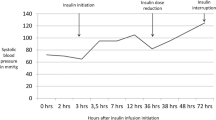Abstract
Clonidine is a central alpha(2)-agonist antihypertensive used widely for opioid/alcohol withdrawal, attention deficit hyperactivity disorder and chronic pain management. We describe a case of clonidine withdrawal causing life-threatening hypertensive crisis and stress-induced cardiomyopathy. A 47-year-old man with chronic back pain, treated with clonidine for many years via intrathecal pump (550 mcg/24 h), presented following a collapse and complaining of sudden worsening of back pain, severe headache, diaphoresis, nausea and vomiting. A few hours prior to presentation, his subcutaneous pump malfunctioned. On presentation, vital signs included pulse 100 bpm, BP 176/103 mmHg, temperature 37.8 °C and O2 saturation 100 % (room air). Acute clonidine withdrawal with hypertensive crisis was suspected. Intravenous clonidine loading dose and a 50 mcg/h infusion were commenced. Five hours later, severe chest pain, dyspnoea, tachycardia, hypoxia, with BP 180/120 mmHg and pulmonary edema ensued. ECG showed sinus tachycardia with no ST elevation. Repeated intravenous clonidine doses were given (25 mcg every 5–10 min), with ongoing clonidine infusion to control blood pressure. Glyceryl trinitrate infusion, positive pressure ventilation and intravenous benzodiazepines were added. Bedside echocardiogram showed stress-induced cardiomyopathy pattern. Serum troponin-I was markedly elevated. His coronary angiography showed minor irregularities in the major vessels. Over the next 3 days in the ICU, drug infusions were weaned. Discharge was 12 days later on oral clonidine, metoprolol, perindopril, aspirin and oxycodone-SR. Two months later, his echocardiogram was normal. The intrathecal pump was removed. We report a case of stress-induced cardiomyopathy resulting from the sudden cessation of long-term intrathecal clonidine. This was managed by re-institution of clonidine and targeted organ-specific therapies.


Similar content being viewed by others
References
Viera AJ. Resistant hypertension. J Am Board Fam Med. 2012;25(4):487–95.
Kosman ME. Evaluation of clonidine hydrochloride (catapres). A new antihypertensive agent. JAMA. 1975;233(2):174–6.
Eisenach JC, De Kock M, Klimscha W. Alpha 2-adrenergic agonists for regional anesthesia. A clinical review of clonidine (1984–1995). Anesthesiology. 1996;85(3):655–74.
Gowing L, Farrell M, Ali R, White J. Alpha2 adrenergic agonists for the management of opioid withdrawal. Cochrane Database Syst Rev. 2004;4:CD002024.
Daviss WB, Patel NC, Robb AS, et al. Clonidine for attention-deficit/hyperactivity disorder: II. ECG changes and adverse events analysis. J Am Acad Child Adolesc Psychiatry. 2008;47(2):189–98.
Kumar A, Maitra S, Khanna P, et al. Clonidine for management of chronic pain: a brief review of the current evidences. Saudi J Anaesthesiol. 2014;8(1):92–6.
McDonald CA, Guttinger R, Joyce D. Case report: clonidine withdrawal after atypically high-dose maintenance treatment. J Paediatr Child Health. 2005;41(11):609–10.
Lanford W, Myrick H, O’Bryan E, et al. A severe case of clonidine dependence and withdrawal. J Psychiatr Pract. 2003;9(2):167–70.
Berge KH, Lanier WL. Myocardial infarction accompanying acute clonidine withdrawal in a patient without a history of ischemic coronary artery disease. Anesth Analg. 1991;72(2):259–61.
Jain P, Misra A. Non-sustained ventricular tachycardia following clonidine withdrawal. Postgrad Med J. 1991;67(786):403–4.
Nakagawa S, Yamamoto Y, Koiwaya Y. Alpha receptors and ventricular tachycardia after clonidine withdrawal. Br Heart J. 1986;56(2):194.
Simic J, Kishineff S, Goldberg R, et al. Acute myocardial infarction as a complication of clonidine withdrawal. J Emerg Med. 2003;25(4):399–402.
Abrich V, Martin P, Hennick M. Vertebral artery dissection and lateral medullary stroke associated with neck trauma and clonidine withdrawal. N Am J Med Sci. 2013;5(7):443–4.
Hansson BG, Hökfelt B. Changes in blood pressure, plasma catecholamines and plasma renin activity during and after treatment with tiamenidine and clonidine. Br J Clin Pharmacol. 1981;11(1):73–7.
Fitzgibbon D, Rapp S, Butler S, et al. Rebound hypertension and withdrawal associated with discontinuation of an infusion of epidural clonidine. Anesthesiology. 1996;84(3):729–31.
Mehta JL, Lopez LM. Rebound hypertension following abrupt cessation of clonidine and metoprolol. Treatment with labetalol. Arch Intern Med. 1987;147(2):389–90.
Komamura K, Fukui M, Iwasaku T, Hirotani S, Masuyama T. Takotsubo cardiomyopathy: pathophysiology, diagnosis and treatment. World J Cardiol. 2014;6(7):602–9.
Scantlebury DC, Prasad A. Takotsubo cardiomyopathy. Circ J. 2014;78(11):2803.
Patankar GR, Choi JW, Schussler JM. Reverse takotsubo cardiomyopathy: two case reports and review of the literature. J Med Case Rep. 2013;7:84.
Wittstein IS. Stress cardiomyopathy: a syndrome of catecholamine-mediated myocardial stunning? Cell Mol Neurobiol. 2012;32(5):847–57.
Author information
Authors and Affiliations
Corresponding author
Rights and permissions
About this article
Cite this article
Lee, H.M.D., Ruggoo, V. & Graudins, A. Intrathecal Clonidine Pump Failure Causing Acute Withdrawal Syndrome With ‘Stress-Induced’ Cardiomyopathy. J. Med. Toxicol. 12, 134–138 (2016). https://doi.org/10.1007/s13181-015-0505-9
Published:
Issue Date:
DOI: https://doi.org/10.1007/s13181-015-0505-9




